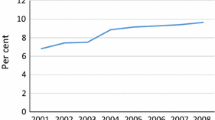Abstract
Entrepreneurship capital has frequently been characterized as an important determinant of regional economic growth. Yet, we have limited knowledge about what explains why certain regions are more successful in creating entrepreneurship capital in general and in particular in technology- and knowledge-intensive sectors. In this paper, we shed light on the skill base of a region in terms of its endowment with human capital and the composition, i.e. specialization or diversity, of skills. Moreover, we look at the context in which entrepreneurship capital formation takes place by focusing on differences in the institutional infrastructures for entrepreneurship in two European countries: Germany and Portugal. Based on harmonized datasets, our results indicate important differences between the countries. Specifically, our results suggest that both specialization and diversity theories hold, and that the effects are thus contingent on regional factors.


Similar content being viewed by others
Notes
We excluded the autonomous regions of Azores and Madeira due to data availability.
In November 2001, two regions in the state of Lower Saxony were merged. From 2002 on the values of the variables for the formerly independent regions are thus equal. Germany has experienced several changes in its regional structure over the past decades which creates particular challenges for the collection of data. Widespread changes occurred from 2007 to 2011, resulting in only 402 NUTS-3 regions in 2013.
For Germany, using data from the LIAB involves the restriction that some NUTS-3 regions, particularly in Eastern Germany, have been aggregated to microcensus regions in order to fulfil the minimum size requirements of 100,000 inhabitants. As a result, the 439 NUTS-3 regions are combined to 343 microcensus regions. Our analyses are based on the NUTS-3 regions, and therefore the two measures for the skill base had to be disaggregated in order to be merged with the other regional data. As both measures are shares, we decided to use the same value for every NUTS-3 region combined into a microcensus region, thus slightly reducing the variance for these measures.
These professions refer to the International Standard Classification of Occupations (ISCO-88) of the International Labour Organisation (ILO), Occupations in Science and Engineering Codes 211–214, 221–223, 244, 245.
References
Acs, Z., & Varga, A. (2005). Entrepreneurship, agglomeration and technological change. Small Business Economics, 24, 323–334.
Andersson, R., Quigley, J. M., & Wilhelmsson, M. (2005). Agglomeration and the spatial distribution of creativity. Papers in Regional Science, 84, 445–464.
Arrow, K. (1962). The economic implications of learning-by-doing. Review of Economic Studies, XXIX(June), 155–173.
Audretsch, D. B., Bönte, W., & Keilbach, M. (2008). Entrepreneurship capital and its impact on knowledge diffusion and economic performance. Journal of Business Venturing, 23, 687–698.
Audretsch, D. B., & Feldman, M. P. (2004). Knowledge spillovers and the geography of innovation, Chapter 61 in Handbook of regional and urban economics (Vol. 4, pp. 2713–2739). Amsterdam: Elsevier.
Audretsch, D. B., & Keilbach, M. (2004a). Does entrepreneurship capital matter? Entrepreneurship Theory and Practice, 28, 419–429.
Audretsch, D. B., & Keilbach, M. (2004b). Entrepreneurship capital and economic performance. Regional Studies, 38, 949–959.
Audretsch, D. B., & Keilbach, M. (2007). The localisation of entrepreneurship capital: Evidence from Germany. Papers in Regional Science, 86, 351–365.
Audretsch, D. B., & Keilbach, M. (2008). Resolving the knowledge paradox: Knowledge-spillover entrepreneurship and economic growth. Research Policy, 37, 1697–1705.
Audretsch, D. B., Keilbach, M., & Lehmann, E. (2005). The knowledge spillover theory of entrepreneurship and technological diffusion. In G. D. Libecap (Ed.), University entrepreneurship and technology transfer (advances in the study of entrepreneurship, innovation & economic growth, Vol. 16) (pp. 69–91). Bradford: Emerald Group Publishing.
Baptistam R., & Preto, M. T. (2007) New firm formation and employment growth: Differences between regions. In 47th Congress of the ERSA, Paris, France, August 29–September 2.
Baumgartner, D., Putz, M., & Seidl, I. (2013). What kind of entrepreneurship drives regional development in European non-core regions? A literature review on empirical entrepreneurship research. European Planning Studies, 21, 1095–1127.
Beaudry, C., & Schiffauerova, A. (2009). Who’s right, Marshall or Jacobs? The localization versus urbanization debate. Research Policy, 38, 318–337.
Boschma, R., & Lambooy, J. (1999). Evolutionary economics and economic geography. Journal of Evolutionary Economics, 9, 411–429.
Cabral, L. M. B., & Mata, J. (2003). On the evolution of the firm size distribution: Facts and theory. American Economic Review, 93, 1075–1090.
Cesário, M., & Vaz, M.-T. (2004). Territory and entrepreneurial performance—An exercise on some industrial Portuguese regions. ERSA conference papers ersa04p179, European Regional Science Association.
Cohen, W. M., & Levinthal, D. A. (1989). Innovation and learning: The two faces of R&D. The Economic Journal, 99, 569–596.
de Vor, F., & de Groot, H. (2010). Agglomeration externalities and localized employment growth: The performance of industrial sites in Amsterdam. Annals of Regional Science, 44, 409–431.
Driscoll, J. C., & Kraay, A. C. (1998). Consistent covariance matrix estimation with spatially dependent panel data. Review of Economics and Statistics, 80, 549–560.
Eckey, H. F., Schwengler, B., & Türck, M. (2007). Vergleich von deutschen Arbeitsmarktregionen. IAB Discussion paper no. 3/2007, Nuremberg.
Faria, P., & Schmidt, T. (2012). International cooperation on innovation: Firm-level evidence from two European countries, Innovation: Management. Policy & Practice, 14, 303–323.
Faria, P., & Sofka, W. (2010). Knowledge protection strategies of multinational firms—A cross-country comparison. Research Policy, 39, 956–968.
Feldman, M. P., & Audretsch, D. B. (1999). Innovation in cities: Science-based diversity, specialization and localized competition. European Economic Review, 43, 409–429.
Fritsch, M., & Falk, O. (2007). New firm formation by industry over space and time: A multi-level analysis. Regional Studies, 41, 157–172.
GEM Report. (2004). Global Entrepreneurship Monitor, 2004 Executive Report. http://www.gemconsortium.org/report.
GEM Report. (2014). Global Entrepreneurship Monitor, 2014 Global Report. http://www.gemconsortium.org/report.
Geroski, P. A. (1995). What do we know about entry? International Journal of Industrial Organization, 13, 421–440.
Glaeser, E. L., Kallal, H. D., Scheinkman, J. A., & Shleifer, A. (1992). Growth in cities. Journal of Political Economy, 100, 1126–1152.
Griliches, Z. (1979). Issues in assessing the contribution of research and development to productivity growth. Bell Journal of Economics, 10, 92–116.
Grimpe, C., & Patuelli, R. (2011). Regional knowledge production in nanomaterials: A spatial filtering approach. Annals of Regional Science, 46, 519–541.
Heitor, M., Horta, H., & Mendonça, J. (2014). Developing human capital and research capacity: Science policies promoting brain gain. Technological Forecasting and Social Change, 82, 6–22.
Hidalgo, C., & Hausmann, R. (2009). The building blocks of economic complexity. Proceedings of the National Academy of Sciences of the United States of America, 106, 10570–10575.
Jaffe, A. B., Trajtenberg, M., & Henderson, R. (1993). Geographic localization of knowledge spillovers as evidenced by patent citations. The Quarterly Journal of Economics, 108, 577–598.
Lee, S., Florida, R., & Acs, Z. (2004). Creativity and entrepreneurship: A regional analysis of new firm formation. Regional Studies, 38, 879–891.
Lucas, R. (1988). On the mechanics of economic development. Journal of Monetary Economics, 22, 3–42.
Marshall, A. (1920). Principles of economics (8th ed.). London: Macmillan.
Maskell, P., & Malmberg, A. (1999). Localised learning and industrial competitiveness. Cambridge Journal of Economics, 23, 167–185.
Rosenthal, S. S., & Strange, W. C. (2005). The geography of entrepreneurship in the New York metropolitan area. FRBNY Economic Policy Review, December 2005, 29–53.
Shane, S. (2000). Prior knowledge and the discovery of entrepreneurial opportunities. Organization Science, 11, 448–469.
Zucker, L., Darby, M. R., & Armstrong, J. (1998). Intellectual human capital and the birth of U.S. biotechnology enterprises. American Economic Review, 88, 290–306.
Acknowledgments
The authors thank Melanie Arntz, Terry Gregory, Georg Metzger, Roberto Patuelli and the Portuguese Ministry of Economy for providing the data used in this study. Moreover, the authors thank Christian Rammer and the special issue editors Rosa Caiazza and David Audretsch as well as two anonymous reviewers for helpful comments and discussions.
Author information
Authors and Affiliations
Corresponding author
Rights and permissions
About this article
Cite this article
Mendonça, J., Grimpe, C. Skills and regional entrepreneurship capital formation: a comparison between Germany and Portugal. J Technol Transf 41, 1440–1456 (2016). https://doi.org/10.1007/s10961-015-9444-5
Published:
Issue Date:
DOI: https://doi.org/10.1007/s10961-015-9444-5




